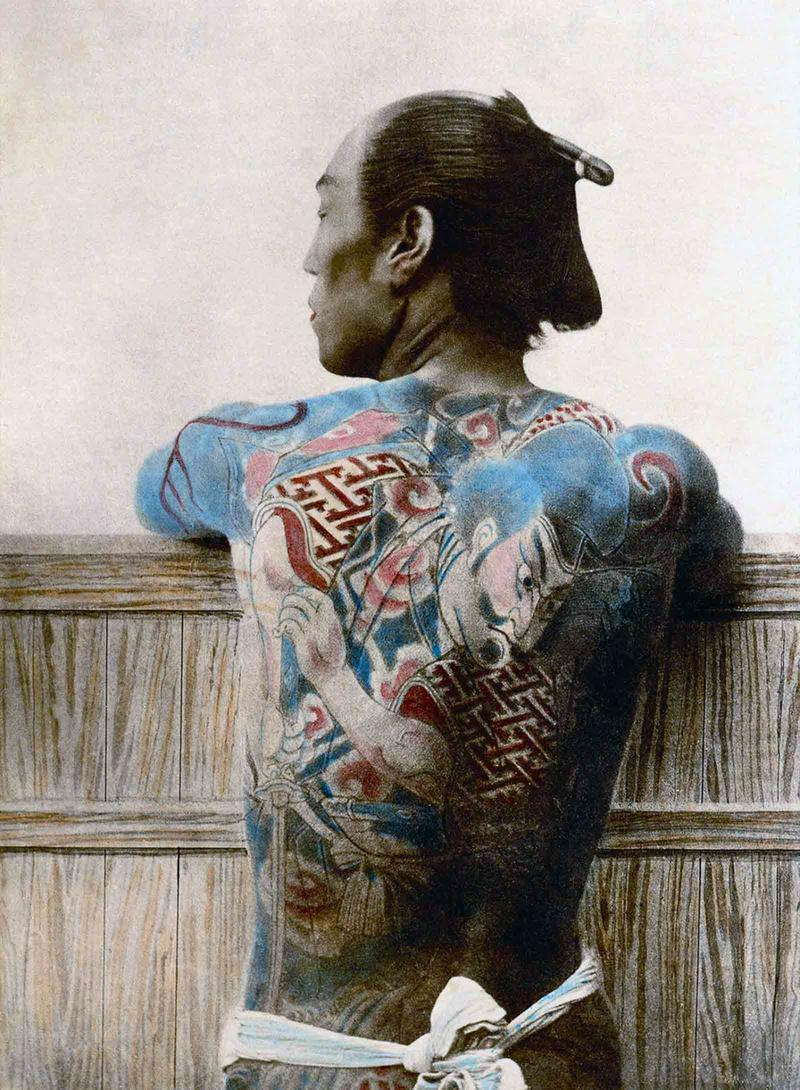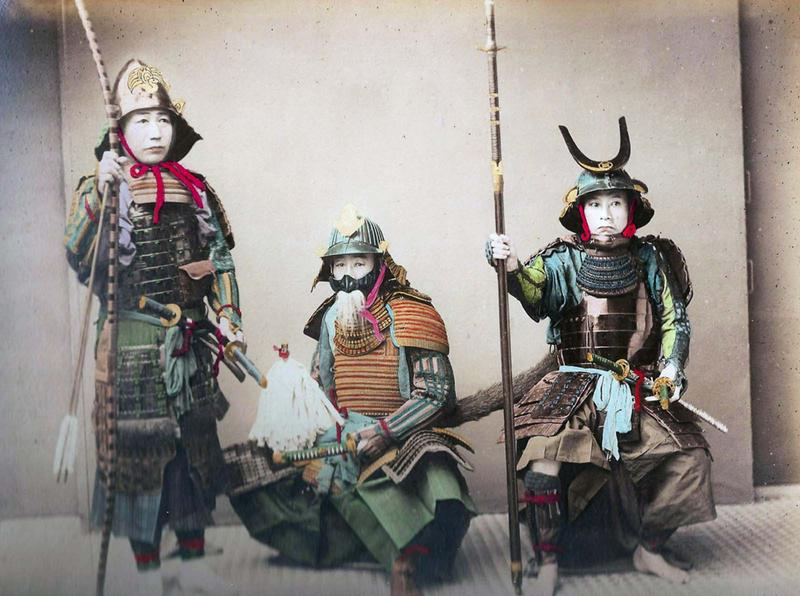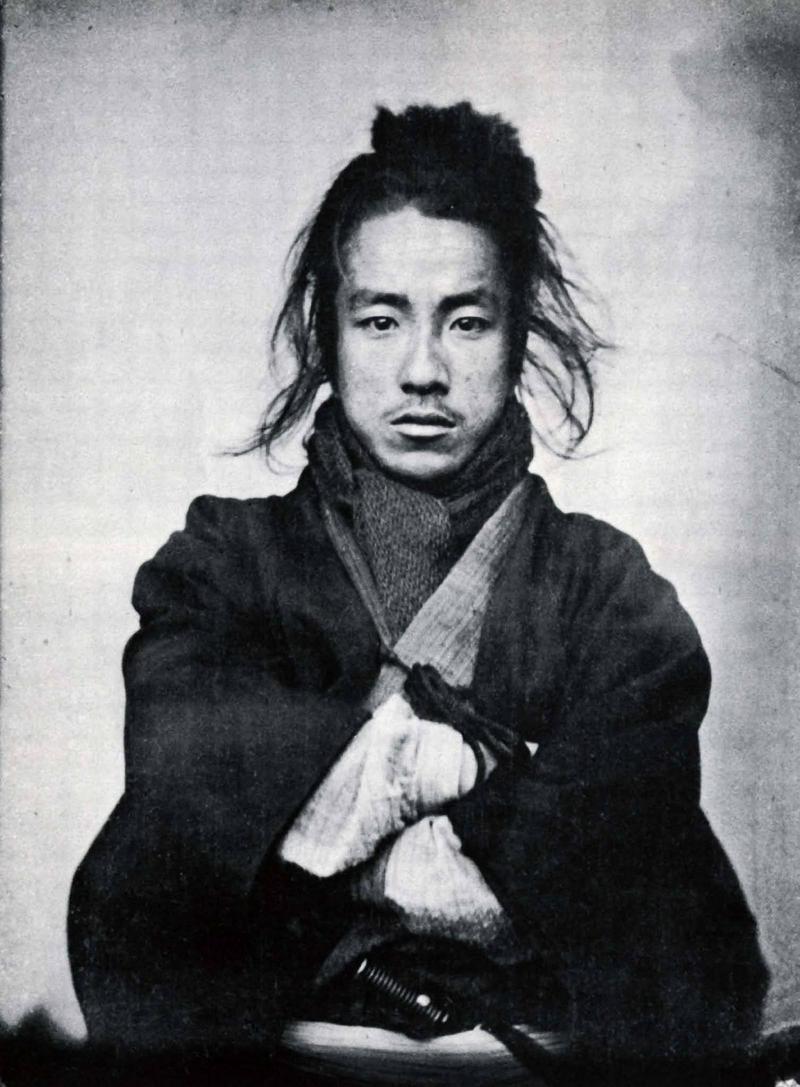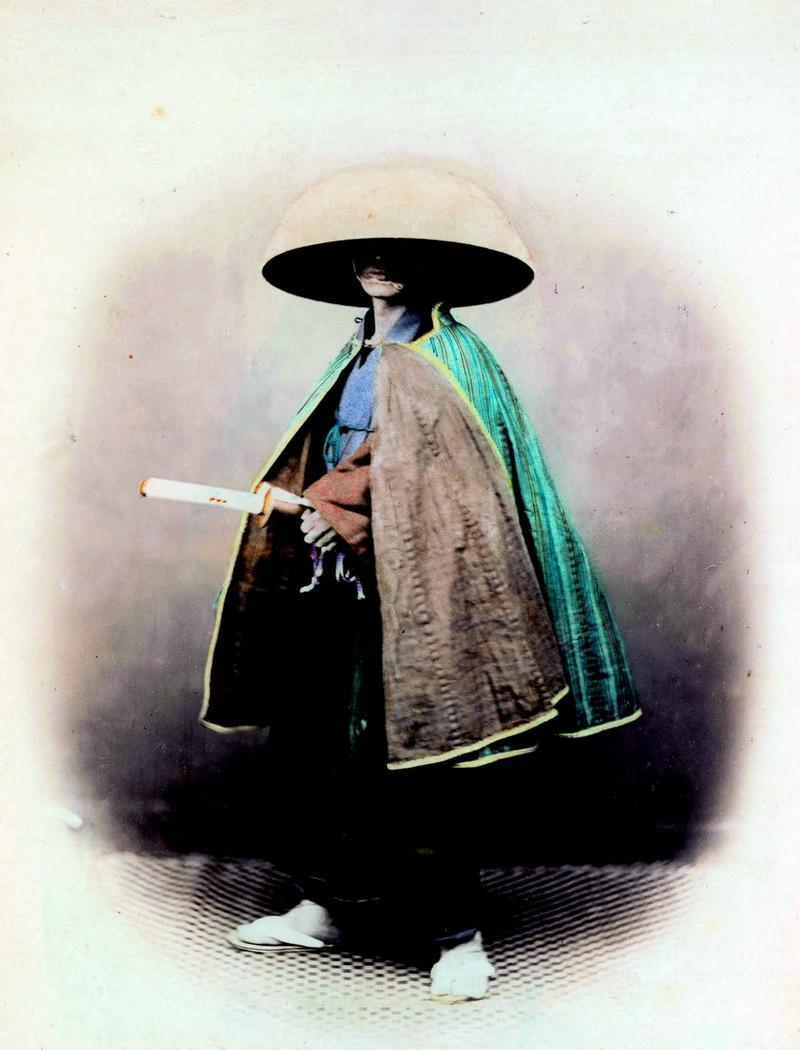Rare Photos Of Samurai We Never Knew Existed
By Sophia Maddox | December 18, 2023
Ink and Honor: The Tattooed Samurai of 1882
Prepare to embark on a captivating visual journey into the world of the Samurai, those enigmatic warriors whose legacy continues to inspire and intrigue. Through a collection of striking images, we will delve into the world of these esteemed warriors and their iconic swords, the Katana and Wakizashi. These images allow us to glimpse their distinctive attire, weapons, and the embodiment of Bushido, the code that guided their lives. From their origins in the Heian period as "mono-no-fu" and "bushi" to their transformation into scholars and public officials during the Tokugawa Era, these visuals will transport you back in time to a world of honor, loyalty, and discipline. Join us as we explore the historical significance and enduring influence of the Samurai.

In the twilight of the 19th century, a stunning photograph from 1882 immortalizes a Tattooed Samurai, his body adorned with intricate artwork that tells a story of battles fought and honor upheld. These mesmerizing tattoos, an art form steeped in tradition, represent more than just ink on skin; they embody the warrior's indomitable spirit. This captivating image offers a glimpse into a time when tattoos were a symbol of courage and unwavering dedication to the Samurai code. It's a testament to the enduring legacy of these noble warriors, whose marks of honor still resonate in the modern world.
The Samurai's Signature: Wakizashi Swords in 1900

In the year 1900, a group of Japanese Samurai proudly donned their traditional attire, their presence marked by the unmistakable Wakizashi swords they carried. These midsize blades, often paired with the larger Katana, were a symbol of their samurai status, a "big-little" testament to their martial heritage. Wakizashi swords typically measured between 12 and 24 inches, showcasing the exquisite craftsmanship of the time. Each one was adorned with decorative accents, including tsuba (guards), habaki (blade sleeves), menkui (handle ornaments), and kashira (pommels), creating an elegant and timeless look reminiscent of the ancient wakizashi carried by the samurai of old.
Oda Nobuyoshi: Dentist, Retainer, and the Enigma of Meiji Japan

During Japan's transformative Meiji Era (1868-1912), we encounter the intriguing figure of Oda Nobuyoshi, a dentist whose life was shrouded in mystery. This captivating photograph, taken in 1880 when he was just 20 years old, raises a multitude of questions. While practicing dentistry during a time of profound change, Nobuyoshi's association with the renowned Iga clan, famous for their ninja heritage, adds an enigmatic layer to his story. What exactly his role entailed remains a mystery lost to time, inviting us to delve deeper into the shadowy realms of history and intrigue. Nobuyoshi stands as a symbol of the Meiji Era's complexity, where tradition met innovation, and the old world gave way to the new.
Ikeda Nagaoki: A Glimpse of Samurai Nobility

In 1864, the lens of history captured the dignified countenance of Ikeda Nagaoki, a Samurai whose legacy still resonates today. This compelling photograph provides a unique window into the life of a distinguished warrior, showcasing the intricate details of his traditional armor and the undeniable presence in his posture. Ikeda Nagaoki's story transcends generations, serving as a testament to the unwavering loyalty and valor that defined the Samurai class. In this rare image, we glimpse the spirit of a bygone era, a time when honor and duty were paramount, and Samurai like Ikeda Nagaoki stood as paragons of nobility.
The Warrior Monk of Kamakura

In this remarkable photograph dating back to 1895, we encounter a sight that defies convention: a fighting monk adorned in the military garb of the Kamakura period. This captivating image challenges our perception of spirituality and martial prowess, as this monk embodies the convergence of inner serenity and battlefield valor. During the Kamakura era, these warrior monks were a force to be reckoned with, defending temples and embodying the duality of enlightenment and combat.
Diplomacy in the Age of the Samurai

This captivating photo from 1862 reveals a little-known chapter in Samurai history. It features an esteemed officer of the Japanese Embassy, donned in traditional attire, showcasing the unique blend of honor, elegance, and authority that defined these ancient warriors. Beyond the battlefield, they played crucial roles in diplomacy, fostering cultural exchange in a rapidly changing world. This image offers a rare glimpse into their diplomatic endeavors during a pivotal moment in Japan's history.
The Dual Blades of a Samurai's Soul

Step back in time to the years 1860-1865 and witness the embodiment of the Samurai code in this striking image. Here, a Samurai proudly displays his long and short swords, symbolizing his unwavering commitment to honor and duty. With one hand on the katana, representing his lethal precision, and the other on the wakizashi, signifying his readiness for close combat, this photo captures the essence of a warrior's spirit. It's a rare glimpse into the intimate relationship between a Samurai and his blades, a connection that defined their identity and purpose in a rapidly changing Japan.
Nakaoka Shintarō: The Heroic Revolutionary Samurai

The year 1866 witnessed the indomitable spirit of Nakaoka Shintarō, a Samurai who left an indelible mark on Japan's history. In this captivating photograph, we encounter a glimpse of the man who would become a revolutionary icon. Clad in traditional attire, Nakaoka Shintarō embodies the duality of a warrior-poet, a visionary who dared to challenge the status quo. His story intertwines with the tumultuous times of the late Edo period, as he played a pivotal role in the movement to overthrow the Shogunate. This rare photo serves as a portal to a time of change and upheaval, when Samurai like Nakaoka Shintarō stood at the forefront of Japan's transformation.
The Enigmatic Archer: Face of Tradition

In the enigmatic year of 1867, this photograph captures a mesmerizing scene—a Samurai archer with a face painted in the ancient traditions of his craft. With his bow poised and eyes focused, he represents a lineage of warriors who blended martial prowess with spiritual reverence. The paint on his face signifies not only his readiness for battle but also a deep connection to centuries of archery wisdom. This image transports us to a world where every detail mattered, and where the path of the arrow mirrored the soul of the Samurai. It's a rare glimpse into a timeless tradition that defined both the art and heart of these legendary warriors.
The Seated Warrior

This hauntingly beautiful photograph immortalizes the innocence and poise of a young seated warrior. With a resolute yet tranquil gaze, he embodies the essence of youthful determination in the shadow of a warrior's destiny. His presence evokes a sense of mystery, inviting us to ponder the untold tales of his training and aspirations. This image transcends time, reminding us that even the youngest among the Samurai held within them the potential for greatness, embracing a legacy that would shape the course of history.
Guardians of the Past: The Samurai Face Mask

In the 1860s, a period marked by upheaval and change, this photograph immortalizes a Samurai fully armored and wearing a face mask. This remarkable image offers a vivid glimpse into the evolution of Samurai defense techniques as they adapted to the challenges of a transforming world. The face mask, both practical and symbolic, represents the dedication to their craft, while the intricate armor reflects the fusion of tradition and innovation. As we peer into this photo, we encounter the unwavering spirit of these warriors, standing as sentinels of their time, ready to face the unknown with resilience and honor.
Shinsengumi: The Unflinching Samurai Brotherhood

Between the years 1858 and 1868, a brotherhood of unwavering Samurai known as the Shinsengumi arose in Japan, fiercely defending the Shogunate during a tumultuous era. This rare photograph captures the essence of these stalwart warriors, resolute in their allegiance and dedication. Cloaked in traditional attire, their swords at their sides, the Shinsengumi embodied the values of honor, duty, and loyalty. This image offers a glimpse into a chapter of Japanese history marked by chaos and change, showcasing the indomitable spirit of the Samurai who stood united in the face of adversity as the old order gave way to a new era.
Guido Verbeck: Bridging Cultures through Education - 1867

Taken in 1867, this remarkable photograph captures the renowned Guido Verbeck, a Dutch scholar and missionary, surrounded by his eager Japanese students. Against the backdrop of a rapidly changing Japan, Verbeck played a pivotal role in fostering cross-cultural understanding. His commitment to education transcended borders, and this image reflects his vision of a harmonious future where East and West coexist. The faces of his students radiate curiosity and hope, symbolizing the power of education to bridge divides and shape a new era.
Kusari Katabira: The Chain-Armor Jackets of Samurai Lore

Enter the world of Samurai fashion with the iconic Kusari Katabira, the chain-armor jackets that embodied both style and protection. Crafted from meticulously interlinked metal rings, these garments served as both functional armor and expressions of Samurai finesse. Explore the historical significance of Kusari Katabira and their integral role in the Samurai's martial arsenal. Delve into the fascinating tale behind these chain-armored jackets, a testament to the enduring legacy of the Samurai heritage.
The Choshu Clan Samurai: Defenders of Tradition in the Turbulent 1860s

Amid the chaos of the 1860s and the Boshin War, this captivating photograph brings to life the stalwart Samurai of the Choshu Clan. Clad in their distinctive armor, these warriors symbolize the unwavering dedication to their clan and their role in the dramatic clash between tradition and modernity. In this rare glimpse, we witness the Choshu Clan Samurai as guardians of their heritage, standing resolute in a time of transformative upheaval, embodying the spirit of the Samurai in its purest form.
1867 Samurai: The Swordmaster's Posing Art

In the midst of the year 1867, a moment in history steeped in change and uncertainty, we encounter a Samurai in this evocative photograph, proudly posing with his sword. With an air of timeless honor, his posture resonates with the grace and precision that defined these legendary warriors. This image, captured at a crossroads in Japan's evolution, offers a glimpse into the enduring connection between Samurai and their cherished blades, where each stance represents not only skill but also the indomitable spirit of a bygone era.
Henmi Sōsuke

In an era lost to time, the mysterious figure of Henmi Sōsuke graces us with his presence. This captivating photograph unveils a glimpse of a Samurai shrouded in enigma, whose story remains untold. With a gaze that seems to pierce through the ages, Henmi Sōsuke represents the enduring mystique of the Samurai, whose deeds and secrets are woven into the fabric of Japanese lore.
1860's Female Samurai: Unveiling the Warrior Spirit

During the 1860s, an era dominated by male warriors, this remarkable photograph introduces us to a trailblazing female Samurai. With her resolute gaze and the traditional armor that defies gender norms, she embodies the indomitable spirit of a woman who dared to challenge convention. This image is a testament to the courage and strength of female warriors who, against all odds, carved their place in history, leaving an indelible mark on the legacy of the Samurai. In her determined stance, we glimpse the untold stories of courage, resilience, and empowerment that defined this remarkable period.
The Last Stand of the Samurai: 1870

In the aftermath of the Bakumatsu, a watershed moment that marked the end of over two centuries of Samurai rule, this haunting photograph captures a lone Samurai in full armor. Standing amidst the shifting tides of history, he represents the twilight of an era, where the Samurai had surrendered their control, and a new government emerged under the Emperor's banner. In his battle-worn armor, this solitary figure embodies the resilience and honor of a bygone age.
The Samurai Portrait by Franz von Stillfried-Ratenicz, circa 1881

Travel back in time to the late 19th century through this exquisite hand-colored photograph by Franz von Stillfried-Ratenicz, captured circa 1881. In this masterpiece, the essence of a Japanese Samurai is brought to life in vivid hues. The meticulous artistry of hand-coloring enhances the already captivating image, accentuating the grace, dignity, and intricate details of the warrior's attire. It's a window into a lost era when the Samurai's legacy was preserved not only in their actions but also in the artistry of the lens. This remarkable portrait stands as a testament to the enduring fascination with the Samurai and their timeless allure.
Felice Beato's Dual Warriors: Capturing Samurai in 1866-67

In the late 19th century, the distinguished photographer Felice A. Beato (ca. 1833–ca. 1909) ventured to Japan, wielding his camera as a means to chronicle the nation's transformative era. Nestled in the treaty port of Yokohama, Beato's lens unearthed a world where tradition met modernity. In 1866-67, he immortalized two Samurai, their presence a testament to a bygone era even as Japan forged ahead. Beato's remarkable photography paints a vivid portrait of the Samurai, capturing their timeless spirit and unwavering commitment to honor.
Samurai in Firefighter Attire: Guardians of the Flame - 1865

In the midst of a bustling and rapidly modernizing Japan in 1865, this rare photograph captures a unique sight: two Samurai dressed in the attire of firefighters. With their traditional weapons at their sides, they embody the duality of their role, as both warriors and protectors of their communities. These Samurai-turned-firefighters reflect a society in transition, where ancient traditions met the urgent need for fire prevention in a changing urban landscape. This image offers a glimpse into a lesser-known aspect of Samurai life, where duty and honor extended beyond the battlefield, and where their legacy as defenders persisted in new forms.
Yokohama's Silent Sentinel: A Samurai in 1865

In the bustling port city of Yokohama, the year 1865 unfurled a tableau that captured the essence of an era in transition. This compelling photograph immortalizes a Samurai, a guardian of honor and tradition, in an environment where East met West. Here, against the backdrop of a rapidly modernizing Japan, the Samurai's presence is a glimpse into a bygone era. With his Stoic posture and traditional attire, he stands as a living testament to the enduring spirit of the Samurai, even in the face of sweeping change. This image beckons us to ponder the clash of cultures and the indomitable legacy of Japan's noble warriors in a world transformed.
Elegance in Ceremonial Garb: Felice Beato's 1868 Portrait of a Samurai 'Yakonin'

In a vivid splash of color, Felice Beato's photograph from around 1868 unveils a Samurai 'Yakonin' resplendent in ceremonial attire. Beato's artistry breathes life into this striking image, which captures not just a warrior but a guardian of tradition. The Samurai's ceremonial dress symbolizes a timeless commitment to honor and heritage, even as Japan underwent profound change during the Meiji Restoration. This portrait invites us to witness a moment of grace and history, as Beato's lens transcends time to convey the enduring allure of Japan's noble Samurai legacy.
Felice Beato's Gaze on a Bygone Warrior - circa 1867

Transporting us to a pivotal moment in Japan's history, this photograph by the renowned Felice Beato (1832-1909) captures the essence of a Samurai warrior from around 1867. Armed with a formidable sword, this Japanese soldier embodies the indomitable spirit of a bygone era when honor, duty, and martial prowess defined the Samurai code. Through Beato's lens, we witness not just a warrior, but a symbol of a nation in transition, where tradition met the winds of change. This photograph stands as a testament to Beato's mastery of his craft, as he immortalized the timeless allure of the Samurai in the late 19th century.
The Seppuku Rite Reimagined: 1897

In 1897, a staged reenactment of the Seppuku ritual was captured, offering a solemn glimpse into Japan's history and traditions. This carefully orchestrated scene pays homage to the profound and tragic act of ritual suicide, where honor outweighed life itself. With meticulous attention to detail, the photograph allows us to contemplate the gravity of a choice made in the name of unwavering commitment to honor. While a staged reenactment, it serves as a poignant reminder of the complex and profound cultural aspects that defined Japan during this period, where tradition and change were in delicate balance.
Samurai Anew in 1890s Japan

In a photographic tribute to Japan's rich heritage, this image from the 1890s resurrects the spirit of the Samurai. A male model, meticulously attired in traditional armor, and gripping a katana, embodies the timeless grace and strength of these legendary warriors. The photograph, a window to the past, captures the essence of a bygone era, where honor and valor were the pillars of a Samurai's identity.
Yukichi Fukuzawa: A Visionary in 1862

In the year 1862, a portrait of Yukichi Fukuzawa emerges, capturing the essence of a visionary thinker during a transformative period in Japan's history. With a gaze that penetrates the confines of tradition, Fukuzawa embodied the spirit of intellectual curiosity and enlightenment. As an influential figure in the late Edo and early Meiji periods, he played a pivotal role in Japan's modernization. This image is a testament to his enduring legacy, one that continues to inspire generations as he championed education, critical thinking, and the pursuit of knowledge in a world on the brink of change.
Samurai's Resplendent Armor: A Glimpse from "Labor in Japan" - 1882

This captivating image hails from "Labor in Japan," a significant work authored by Thomas Brodhead Van Buren, who served as the Consul General of the United States in Yokohama from 1874 to 1885. Published in 1882, this photograph is a precious snapshot from Van Buren's comprehensive study, which not only delved into labor practices in Japan but also shed light on the intricate Pottery and Porcelain Industries of the nation during the late 19th century. Here, we glimpse a Samurai adorned in his magnificent armor, a symbol of centuries of tradition and craftsmanship. This photograph encapsulates the artistry and attention to detail characteristic of the era when labor and artistry intersected seamlessly.
Samurai Elegance: Felice Beato's Portrait of Tradition

In the realm of 19th-century photography, Felice Beato's lens captured a timeless image: a Samurai in resplendent traditional attire. This evocative portrait showcases the meticulous craftsmanship of the Samurai's attire, a masterpiece of Japan's cultural heritage. As Beato's lens immortalizes this noble warrior, we are invited to explore the intricate details of his clothing and the unspoken dignity etched in his gaze.

